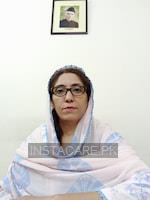Fibroids - Symptoms, Risk factors and Treatment
Last Updated On Tuesday, December 16, 2025
Fibroids in Urdu
فائبروائڈز، جسے لییومیوماس، مایوماس، یا فبروما بھی کہا جاتا ہے وہ غیر معمولی نشوونما ہیں جو خواتین کے رحم کے اندر ہوتی ہیں۔ وہ عام طور پر بچے پیدا کرنے کی عمر میں ہوتے ہیں۔ شاذ و نادر ہی وہ کینسر کی نشوونما میں بدل جاتے ہیں۔ جب وہ سائز میں بڑھتے ہیں تو وہ درد اور بہت زیادہ ماہواری خون کا باعث بنتے ہیں۔ وہ ایک انکر کے سائز سے لے کر ایک بڑی گیند تک ہوتے ہیں۔ بعض اوقات یہ اتنا چھوٹا ہو سکتا ہے کہ یہ ننگی آنکھ سے پوشیدہ رہ جائے۔ جب کہ بعض اوقات یہ اتنا بڑھ جاتا ہے کہ وزن بڑھاتا ہے اور آپ کی پسلی کے پنجرے کو دباتا ہے۔
اس کے علاوہ، آپ کو ایک ہی فائبرائڈ یا ایک سے زیادہ ہوسکتا ہے۔ جب یہ وزن میں اضافے اور دیگر علامات کی وجہ سے سائز میں بڑھ جاتا ہے، تو صحت کی دیکھ بھال فراہم کرنے والے اسے جراحی سے ہٹا سکتے ہیں۔ اس کے لیے آپ کو اینستھیزیا لینا پڑے گا۔ تاہم، زیادہ تر وہ کسی پریشان کن علامات کا سبب نہیں بنتے ہیں۔ بہت سی خواتین کو زندگی بھر اس کے بارے میں علم بھی نہیں ہوتا۔ ڈاکٹر قبل از پیدائش کے الٹراساؤنڈ یا شرونیی امتحان کے دوران اس کے بارے میں بصیرت حاصل کر سکتے ہیں۔ یہ ماہواری میں بھاری خون بہنے کا سبب بھی بن سکتا ہے۔ لہذا، اسے جراحی سے ہٹا دیا جا سکتا ہے.
Fibroids in English
Fibroids, also known as leiomyomas, myomas, or fibroma are abnormal growths that occur inside the uterus of the female. They usually occur in childbearing age. Seldom do they turn into a cancerous growth. When they grow in size they cause pain and heavy menstrual bleeding. They range from the size of a seedling to that of a large ball. Sometimes it may be so small that it remains invisible to the naked eye. Whereas sometimes it grows so much that it adds weight and presses your rib cage.
Moreover, you may have a single fibroid or more than one. When it increases in size causing weight gain and other symptoms, the healthcare providers may remove it surgically. For that, you will need to take anesthesia. However, mostly they do not cause any bothersome symptoms. Many women do not even know throughout their lifetimes about it. The doctors can get an insight about it during a prenatal ultrasound or pelvic exam. It may also cause heavy menstrual bleeding. Therefore, it may be removed surgically.
Symptoms
Mostly it does not cause any apparent signs and symptoms. When it shows symptoms in women, they are dependent upon the size, location, and type of fibroid. Rarely do fibroids cause pain and symptoms. They may cause when blood supply to them is disrupted and they are beginning to die.
The most common signs and symptoms of fibroids are;
- Heavy menstrual bleeding with blood clots
- Menstrual periods lasting more than a week
- Pain during sexual intercourse
- Pressure or fullness in your lower abdomen
- Swelling or enlargement of the abdomen
- Pelvic pressure or pain
- Frequent urination
- Difficulty emptying the bladder
- Constipation
- Backache or leg pains
- Heavy bleeding between your periods
- Pain in the pelvis
- Pain in the lower back
- Increased menstrual cramping
Causes
The exact cause of fibroids is unknown. But the following can be the causative agents;
Genetic changes- fibroids may occur due to change in the genes sequencing
Hormones- estrogen and progesterone, the hormones that regulate the menstrual cycle and prepare the body for a possible pregnancy can also cause fibroids.
Therefore, they tend to shrink after menopause.
Insulin-like growth factors
Extracellular matrix
Risk Factors
The risk factors for uterine fibroids are very few known. The most common is a woman of reproductive age. Other risk factors for it are;
Race
Fibroid can occur in any woman. But they are more common in women who are black in the race. Moreover, they may have fibroids at a younger age as compared to other women and may have larger size fibroids with severe symptoms.
Hereditary
If close family members like your mother or sister have a history of fibroid, you are at increased risk of it too.
The other risk factors for fibroids are;
- The onset of menstruation at an early age
- Obesity
- Vitamin D deficiency
- Diet rich in red meat
- A diet lower in fruits and green vegetables
- Drinking alcohol and beer
Treatment
There is no such treatment for uterine fibroids. It is only done if fibroids tend to cause bothersome symptoms. Otherwise, wait watching is done. The treatment options for fibroids may include;
Medications like;
- Gonadotropin-releasing hormone (GnRH) agonists
- Progestin-releasing intrauterine device (IUD)
- Tranexamic acid
Other invasive procedures like;
- Uterine artery embolization
- Radiofrequency ablation
- Laparoscopic or robotic myomectomy
- Hysteroscopic myomectomy
- Endometrial ablation
- Hysterectomy
Conclusion
Fibroids, also known as leiomyomas, myomas, or fibroma are abnormal growths that occur inside the uterus of the female. They usually occur in childbearing age. Seldom do they turn into a cancerous growth. When they grow in size they cause pain and heavy menstrual bleeding. They range from the size of a seedling to that of a large ball. Sometimes it may be so small that it remains invisible to the naked eye. Whereas sometimes it grows so much that it adds weight and presses your rib cage. Moreover, you may have a single fibroid or more than one. When it increases in size causing weight gain and other symptoms, the healthcare providers may remove it surgically.
Frequently Asked Questions
Fibroid meaning in urdu is رحم کی رسولی.
Uterine fibroids are noncancerous growths of the uterus that often appear during childbearing years. Also called leiomyomas (lie-o-my-O-muhs) or myomas, uterine fibroids aren't associated with an increased risk of uterine cancer and almost never develop into cancer.
Symptoms of fibroids can include heavy menstrual bleeding, pelvic pain or pressure, frequent urination or difficulty emptying the bladder, and pain during intercourse. Other symptoms can include anemia, backache, constipation, and abdominal swelling or bloating.
The exact cause of uterine fibroids is unknown, however there are several risk factors associated with the development of fibroids. These include obesity, family history of fibroids, early onset of menstruation, late age of menopause, and not having children.







